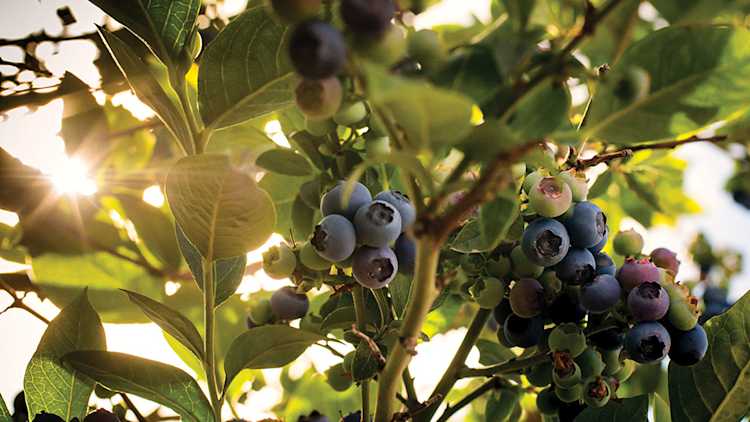Cultivating value: A review of 2024 fruit land price trends

Fresh fruit production is integral to Canadian agriculture. It supports diversity in our nation’s crops, and is a core strength at a time when our trade relationships are facing significant pressures. Further to our 2024 Farmland Values Report, this analysis highlights trends in fruit land values for blueberry farms, apple orchards, cherry and tender fruit orchards, and vineyards.
Fruit crops represent different shares of the overall crop production across the country (Table 1). Regional micro-climates enable notable fruit production. In Atlantic Canada, fruit constitutes 8.6% of crop receipts, whereas in British Columbia, it represents a substantial 14.3%. This underscores how crucial fruit production is for the latter province’s agricultural economy. Last year’s severe cold events in BC had a significant impact on yields, overall production and receipts. Many British Columbia producers had to grapple with everything from crop damage to total crop loss, leading to reduced or in some cases, no harvests. As seen in (Table 1) fruit farm cash receipts have fallen in all provinces and across the country over the past 5-years.
Table 1: Percent (%) fruit contributes to provincial crop receipts
2019 | 2020 | 2021 | 2022 | 2023 | 2024 | |
Canada | 3.4% | 2.9% | 2.6% | 2.6% | 2.4% | 2.4% |
Atlantic | 11.4% | 10.9% | 14.5% | 13.1% | 9.7% | 8.6% |
British Columbia | 23.8% | 21.4% | 20.0% | 18.7% | 18.8% | 14.3% |
Ontario | 4.2% | 3.2% | 3.0% | 2.8% | 3.4% | 3.3% |
Quebec | 8.9% | 8.9% | 7.1% | 7.3% | 6.7% | 7.9% |
Alberta, Manitoba & Saskatchewan have not been included in the above chart as their percent (%) contributions were 0.03% or less.
Sources: Statistics Canada and FCC
This analysis focuses on trends in fruit land values for blueberry farms, apple orchards, cherry and tender fruit orchards and vineyards (Table 2). These values fluctuate based on market demand and climatic events, which highlight the importance of the ever-changing dynamics within the industry. Fruit production occurs in other provinces throughout Canada, however, these regions are not depicted in (Table 2) below because we only report trends for which we have sufficient data.
Table 2: FCC reference Value per acre for Orchards, Blueberries and Vineyards

*The value range represents 90% of the sales in each area and excludes the top and bottom 5%
Source: FCC
British Columbia
After a devastating 2024 season, the vineyard replanting program is fully subscribed and underway, with damage assessments now complete. Fortunately, no further winter damage occurred this year. Last year's harvest was small, with the severity of the year’s weather events impacting the regions and varietals throughout the province. Through this, vineyard values in the Okanagan remained stable with no change. Central Okanagan (Kelowna) values continue to hold steady, while southern regions are seeing softening markets. Notably, cherry land is now valued at or above vineyard land across the region, whereas in the past vineyard land commanded a premium.
Apple yields are projected to be average again this year. However, in 2024, the collapse of the BC Tree Fruits Cooperative left many producers scrambling for storage and packing solutions—prompting increased investment in on-farm climate-controlled facilities for private use. A 5.9% increase has been observed in Okanagan orchard lands over 2024, while orchard land values in the Kootenay’s have softened by -5.0%.
The 2024 blueberry harvest showed a strong recovery across the board. Yields were up, and while prices fluctuated based on variety and market conditions, overall returns were encouraging for growers. Blueberry land values remained stable with a reported no change in values in 2024. Variety played a big role in pricing. Calypso blueberries, for example, saw stronger demand and higher prices compared to Duke, largely due to supply levels at the time of harvest. Looking ahead to this season, the outlook is promising. Current crop conditions suggest another solid year for production. As for pricing, early indications point to stability, with the potential for a modest increase. As always, market dynamics and weather will have the final say, but for now, there’s reason for optimism in the blueberry patch.
For nearly a decade, fruit prices have seen an overall increase (Figure 1). This increase does not reflect the rise in input costs experienced by growers in the past three years, which has impacted profitability. The chart highlight is cherries, with stronger pricing driven upward by the very small crop marketed from 2024’s harsh winter in the Okanagan.
Figure 1: Canadian average prices per kilogram for apples, highbush and lowbush blueberries, grapes and cherries

Sources: Statistics Canada and FCC
Ontario
Vineyard land values have remained stable in Ontario with no change in values in 2024. The warm, dry growing season in Ontario, particularly in Niagara, set the stage for an early harvest and generally high fruit quality. Summer temperatures were above average, resulting in accelerated maturity and fruit concentration. The dry harvest season allowed extended hang time and optimal harvest conditions. There is still optimism in the industry, and it is fueling strategic expansion, particularly where farmers have been renting neighboring land for years or see a clear opportunity to consolidate operations. The transaction trend is moving toward more farmer-to-farmer transactions.
Quebec
Last year’s Quebec blueberry harvest was average, with significant variability due to late spring frost and summer drought, which reduced fruit size. Insect problems around the Lac St-Jean region added to the challenges. The average value of blueberry farmland climbed by 3.6% over 2024.
Quebec’s 2024 apple harvest far exceeded expectations, reaching a remarkable 124,382 tonnes—up from 93,145 tonnes in 2023 and marking the best yield in a decade. Favorable weather, with balanced rainfall and moderate temperatures, delivered both high volume and excellent fruit quality—an uncommon combination. An early start to the harvest also supported strong market timing for producers. The market of orchard land sales is very limited, we are therefore unable to publish any specific numbers, but values were trending upwards in this province.
New Brunswick
Wild blueberry producers in New Brunswick experienced a difficult season. Although the yields were average this year, blueberry producers sustained another year of difficult pricing. Compounding the issue, market prices fell resulting in widespread financial strain across the sector; during this blueberry land values remained stable with no change in 2024.
Nova Scotia
Blueberry producers in Nova Scotia faced another difficult year in 2024, with prices per pound remaining low and putting profitability under pressure. Sales activity was minimal for blueberry land and showed no reportable change in acre values.
Nova Scotia’s vineyards have returned to full production following the polar vortex. With vines recovering and yields back on track, producers are optimistic. However, the next harvest will be critical in shaping future investment decisions across the region.
In 2024, Annapolis Valley apple growers experienced strong crop sets, but lower market prices led to a drop in overall revenue. While land values remained unchanged, concern is growing around trade dynamics.
Bottom line
The previous year was marked by significant weather and production challenges that impacted yields in fruit production. Despite these difficulties, average fruit land values remained stable, with only minor softening observed. As the 2025 blossoms set, we are hopeful a fruitful harvest lies ahead.
Article by: Megan Mailloux AACI, P. App., Data Analyst
